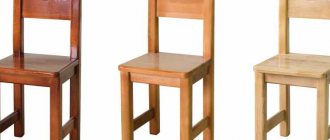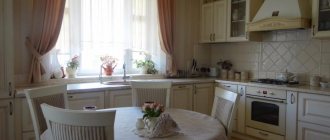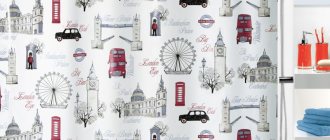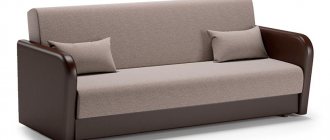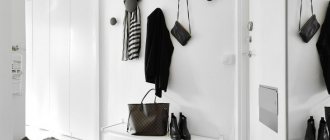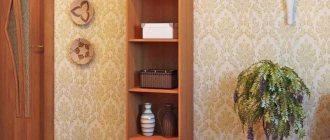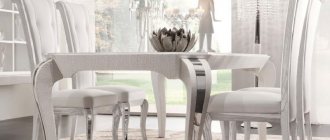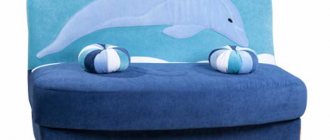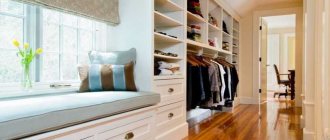Requirements for a desk for a schoolchild
You can optimally organize a workplace for a student by following just a few rules:
- the height of the desk and chair must correspond to the height of the child;
- The optimal ratio is when the table top is at the height of the child’s chest. A table that is too low will force the student to constantly bend over while “lying down” on the desk. This will lead to constant overstrain of the back and neck muscles, which can put pressure on internal organs and contribute to the development of scoliosis. A table that is too high will increase the strain on the neck and shoulder girdle. Prolonged work at a high or low table leads to tension in the eye muscles and can cause vision impairment (for example, accommodation spasm);
- It’s good if the tabletop can be raised at an angle of up to 15 degrees. The child will not tilt his head forward and will become less tired when doing homework;
- There should be no oilcloths, tablecloths or other similar coverings on the writing table. They interfere with writing and distract attention;
- The tabletop area should be sufficient to accommodate a book stand, stacked books, notebooks, and writing instruments.
Choosing a desk for your favorite first-grader!
Hello, dear readers! With every new day, the number of mothers and fathers in stationery and children's clothing stores is growing unspeakably. This is not surprising, because there is very little time left to take a breath and confidently say: “We are ready for school!” Is your home workspace ready for the start of the school year?
Not long ago we discussed the schoolchild’s corner and selected lamps for studying. I propose moving on to fundamental tasks. How to choose a desk for a first grader is a talking point.
How to choose a desk for a schoolchild? Tips for choosing
The question of which furniture to choose for a schoolchild—a desk, a computer desk, or a desk—is asked by every parent. The final decision is yours, and we focus on the important parameters. Desk:
- You can buy it at once for many years. The desk will not stand idle when the child grows up;
- It’s comfortable not only for a child to work at a desk, but also for an adult, if the need arises (especially in times of coronavirus and remote work);
- huge selection. Even for a minimal price you can buy a corner desk, a desk with drawers and shelves that will fit perfectly into any interior;
- for greater versatility, you can buy a desk adapted for working at a computer (with a hole for wires, a compartment for a system unit, etc.). A computer desk is not suitable for educational purposes - there is not enough space on the tabletop;
- For younger students, the desk may be too large. The child will sit incorrectly, so he will quickly get tired and strain his vision.
School desk for schoolchildren:
- Most models can be adjusted in height to suit the height of the child. The student will always have correct posture;
- many models are sold together with a chair, which can also be adjusted in height;
- Many desks allow you to adjust the tilt of the table top. This creates additional convenience, especially for younger students;
- desks are often equipped with folding elements that can increase the area of the tabletop if necessary. There may also be small drawers for storing office supplies.
Criteria for choosing a table for a schoolchild
- Safety: environmentally friendly materials, no sharp corners, reliable fastenings.
- Convenience and comfort.
- Functional content and size. For comfortable work, the tabletop must be more than 1 m long and 0.6-0.8 m wide. To free up space, additional elements are important: cabinets, shelves, racks.
It is important that the student himself participates in choosing a desk. If he likes the workplace, then he will enjoy studying!
Particular attention should be paid to the organization of the first-grader’s workplace. Standard desks have a height of 750 mm, and for a child 6-8 years old this is a lot. Therefore, a growing workplace for a primary school student is what is needed. In this model, the height can be adjusted so that a beginning student is as comfortable as possible.
The chair on which the student will sit during classes also plays an important role. Before you know it, your baby will turn into a teenager! I don’t want to buy a chair for one or two years.
An excellent option would be a growing wooden chair. In this model, you can adjust the height of the seat and footrest, and the back supports the anatomical shape of the spine.
Correct fit
- The tabletop is at the same level as the solar plexus.
- The elbow of a straight lowered arm in a sitting position of a schoolchild is 50 mm below the surface.
- The knees in a sitting position are bent at an angle of 90°.
- The distance from the upper thigh to the working surface is 150 mm.
Material
When choosing a material, consider safety, interior design, wear resistance, strength and durability of the base and coating.
- Chipboard (chipboard) is the most common material. It is made from a mixture of shavings and sawdust along with adhesives. This is a cheap and fairly durable material if you do not expose it to excessive moisture and abrasion. Its disadvantages are fragility and the release of formaldehyde.
- LDSP (laminated chipboard) - the same. like high-quality chipboard, but during the production process the sheet is covered with a polymer film. This is also an inexpensive material, but more stable than its classic counterpart - it is not afraid of high temperatures and moisture. Laminated chipboard sheets are very durable and hold fasteners well, which is why furniture manufacturers love them.
- MDF (Medium Density Fiberboard) is made from wood dust using natural adhesives - lignin and paraffin. MDF is a very environmentally friendly material that does not evaporate harmful compounds, is moisture resistant and quite flexible - it can be easily milled. Therefore, MDF furniture often has unusual curved shapes. The main disadvantage of the material is its high price compared to chipboard and laminated chipboard.
- Solid - the table is made of wooden boards tightly fastened together. Solid wood tables are strong, environmentally friendly, durable, wear-resistant, but at the same time heavy and quite expensive.
- Plastic - plastic desks and tables are mainly produced for primary schoolchildren. They are not very durable (in principle, this is not necessary, since the child grows quickly), but at the same time they are inexpensive. In any case, a plastic table will have to be replaced with a more reliable one already in 2-3 grade.
- Glass – Glass desks are not very common. If you decide to buy, it is better for older students, as younger ones can break it and get hurt by the fragments. In addition, glass is a cold material, and in the fall, before the heating is turned on, working at such a table may be uncomfortable.
- Metal - usually used in combined tables, the working surface of which is still made of wood. Often, metal tables are not mass-produced, but are made to order, taking into account the requirements for a specific interior.
Equipment
A desk for a schoolchild can have different configurations and appearance. An ordinary table is a classic rectangular shape, with drawers on the side. Under the tabletop there can be a shelf where it is convenient to store textbooks. In such models, the tabletop itself has sufficient area: you can comfortably place a monitor or laptop on it. Tandem table. A convenient option if there are 2 schoolchildren in a family of approximately the same age. As a rule, it is equipped with a common tabletop and a system of drawers in the middle or on the sides. Workstations can be located next to each other, or perpendicular to the same tabletop. Computer deskFor middle and high school age, you can buy a computer desk. Its main difference is the retractable bottom shelf for the keyboard and space for the system unit. You need to pay attention to how much free space will remain on the desk after installing the computer. Not all computer desks are convenient for doing homework: the tabletop is often located higher due to the presence of a pull-out shelf, and there is not enough space for a comfortable position at the desk. Corner table Suitable for small rooms, as it will help to rationally use the corner. Despite its compactness, the corner table boasts a decent countertop area. Often, in addition to the table, manufacturers offer a mini-rack or additional shelves. Table with shelves Often looks similar to a classic rectangular table, but there are different options. The main advantage is the large shelves for storing textbooks, which are installed directly on the table, and there is no need to drill into the wall.
Photos of desks
Read here! Corner sofas - the best models, current design ideas and modern design options (130 photos)
Please repost
0
Organization of a schoolchild's workplace
According to the standards, high school students should spend no more than 3 hours on homework. However, in reality, lessons often drag on. To ensure that your child is less tired and his health does not suffer, proper organization of the workspace is important. It is advisable to place the student’s desk near a window to make the most of natural light whenever possible. The light should fall on the left side of the child if he is right-handed, and on the right if he is left-handed. In this case, the shadow of the hand does not fall on the written text, and the eyes are less strained. The table must have a table lamp with the ability to adjust the height and tilt. The workspace should be well lit with natural light or a desk lamp. The light from the chandelier in the room may not be enough. Lighting that is too dim or too bright puts extra strain on the eyes and can impair vision. A chair or armchair for a schoolchild must have a backrest. It would be nice if the chair can be adjusted in height. A child, sitting on a chair, should rest his feet firmly on the floor or, in extreme cases, on a special footrest. Legs hanging from the chair are unacceptable - this posture leads to improper distribution of static load on the musculoskeletal system and develops stooping. While sitting, your legs should be bent at the knees at a right angle. If the chair is too low, the knees form an acute angle, and prolonged sitting in this position can lead to kyphosis, a curvature of the spine in the thoracic region.
Review of table models
Halmar Lima B1
Desk with bedside table and drawer. Made from laminated chipboard. Has a classic shape. Suitable for any interior.
Mebelgrad SP-02
A simple rectangular desk. Made from laminated chipboard. Does not have shelves or drawers.
Sokol KST-106.1
Universal large table. Due to the area of the table top and the layout of the elements, it can be used both as a desk and as a computer desk. Made from laminated chipboard. Has one shelf, one cabinet and 4 drawers.
